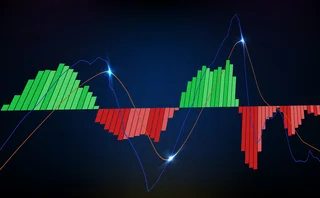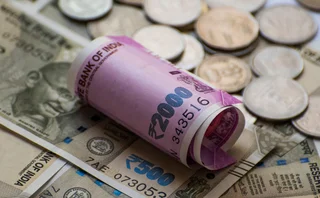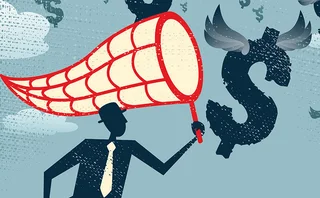
Gambling on dividends
Dividends have caused sizeable losses for dealers and investors over the recent months, as a precipitous fall in expectations has hit structured product issuers and those who participated in dividend swaps. Mark Pengelly investigates

Corporate dividends are one of a number of old certainties in the equity derivatives market to have come unstuck in 2008. "It's been a roller-coaster year for dividends," says Daniel McNeill, head of equity exotics and hybrids for the Americas at JP Morgan in New York.
Earlier this year, dividend risk was one of several parameters that did not act according to plan for structured product desks. Then, correlation and volatility soared at the same time as dividend expectations faltered, delivering a triple blow to dealers' books (Risk July 2008, pages 20-241). Banks are structurally short correlation and volatility and long dividends as a result of popular structured products sold to retail and private banking clients. Consequently, many dealers were forced to record sizeable losses in the first quarter.
More recently, the demise of Lehman Brothers has sent equity markets into a tailspin and triggered regulatory action that has thrown dividend expectations into freefall. Coming with another spike in volatility and correlation, it has led to a second round of losses across banks, running into hundreds of millions of dollars at some institutions. Meanwhile, investors that took positions in the growing dividend swap market have also been hurt, with some hedge funds, in particular, thought to have sustained significant losses.
The dividend swap market has attracted a wide variety of participants in recent years. A benign environment prior to the credit crisis saw corporate earnings on a steady upward path, enabling companies to make attractive dividend payouts to equity investors. "Back then, dividends really were at their peak in terms of interest from non-standard dividend players," recalls McNeill.
For their part, dealers encouraged growth of the dividend market, keen to offset exposures they had accumulated through their structured products businesses. Among the most popular structures in recent years have been reverse convertibles and auto-callables. These products redeem at par and pay a high coupon so long as the reference stock does not fall below a pre-defined barrier level - for instance, 85% of its initial price. If the stock price does fall below this level, the note would redeem in shares.
In buying the note, the investor is implicitly selling a put option that knocks in once the underlying price falls below the barrier. Dealers are therefore long a put, which creates a long dividend position. Crucially, the dealer becomes increasingly long dividends as the underlying stock price drops and nears the barrier.
Even more complex are the worst-of baskets that have also been popular with retail and private banking clients over the past few years. In this case, the notes redeem in the shares of the worst-performing stock if any of the underlyings in the basket drop below the barrier. By adding an element of correlation risk into the trade, the investor is able to earn outsized returns. However, from the issuer's perspective, all the dividend risk is eventually concentrated in a single stock within the basket - the one that performs the worst and the one least likely to pay high dividends.
Not only did the dividend swaps market enable banks to offset at least part of this risk, but investors were also able to take advantage of dealer axes to gain cheap exposure to dividends. While the market initially comprised sophisticated investors such as hedge funds, increasing liquidity began to attract real-money investors, such as pension funds, insurance companies, and retail and private-banking clients. In recent years, forward-starting swaps and dividend options have been traded, along with more advanced steepener or flattener trades.
Investor attention in dividends was piqued by a plausibly sound investment story - simply, that corporate dividends would continue to rise. However, recessionary fears since the US subprime mortgage meltdown have caused expected dividends to fall steeply. Figures from Citi show 2009 Eurostoxx 50 dividend swaps lost 25.2% between July 3, 2007 and October 1, 2008, with the index falling from 181.8 to 136 points. But a much sharper drop was yet to come.
"Over October, the dividend swap curve massively sold off," says Eamonn Long, equity derivatives analyst at Barclays Capital in London. From October 1 to October 31 this year, 2009 Eurostoxx 50 dividend swaps plummeted by a further 26.5%, to 100 points, according to Citi. This dramatic decline was reflected across various maturities, with 2011 Eurostoxx 50 dividend swaps collapsing by 36.4% over the same period to reach 80.7 points.
One of the main reasons for the sell-off was the realisation that financial dividends would be curtailed or suspended in light of government-led rescue schemes. Under the UK government's bank recapitalisation plan announced on October 8, for instance, strict controls are likely to be placed on the payment of dividends by participating institutions (Risk November 2008, page 122). Similarly, the US Treasury's Troubled Assets Relief Program has placed limits on the dividends that can be paid by financial institutions receiving capital infusions.
A growing number of companies are also opting to pay stock dividends in favour of cash dividends. This has helped drive down expectations in Europe, as stock dividends are not included in the Eurostoxx 50 dividend index. "Not only were people afraid of the government schemes, whereby the banks would have to suspend dividends, but they were also afraid of those banks that were independently paying stock dividends," Long says.
Such worries conspired with other technical and fundamental pressures to depress the market. They included the prospect that hedge funds would be forced to unwind long dividend positions in the face of rising investor redemptions, and concern that the strangling of credit would start to affect earnings and dividend payouts by corporates outside the banking sector. "There was fear of leveraged investors having to unwind with forced redemptions. But the icing on the cake was that people were still afraid of what would happen to companies if banks didn't start lending," says Long.
Issuance of reverse convertibles and auto-callables has declined significantly over the past year amid market woes. At the same time, analysts believe many outstanding structures will have been terminated during the recent dive in global stocks. The Dow Jones Eurostoxx 50 index closed at 2,225.99 on November 20 - having lost 48.7% from a level of 4,339.25 at the start of 2008.
But Gerry Fowler, London-based head of equity derivatives strategy at Citi, says there is a possibility structures with more conservative strikes are still causing difficulties for dealers. "I'd say that now, a vast majority of these products are probably knocked in. But, at the same time, there are possibly some out there from previous generations that continue to cause problems," he says.
Despite the existence of methods to hedge dividend exposure, bankers say it is neither practical nor necessarily desirable to eliminate all the dividend risk arising from a large and complex exotic book (see box, Paying dividends?). Instead, some market participants were happy to hold long dividend exposures, expecting dividend payouts to steadily increase.
The financial crisis shattered that view, sparking a rush to lay off long dividend risk. Emmanuel Dray, Paris-based global head of forward trading at BNP Paribas, says that, as dividend expectations fell, many dealers simultaneously entered the market to hedge their exposures. "We've seen a lot of exotic structured product desks trying to flatten their books by cutting exposure and consistently selling dividends in the market."
But with most dealers positioned the same way, liquidity became scarce. "All the visibility and liquidity has been taken out of the index dividend market, both long-dated and short-dated. Short-dated dividends have come under pressure because of the market collapse, and in longer-dated dividends there's just a lack of players in the market," says JP Morgan's McNeill.
Single-stock dividend swaps are generally not as liquid as indexes, so dealers would often look to hedge these names on a forward basis by buying a call option and concurrently selling a put option on the underlying stock. This can be expensive even in normal markets, but since Lehman's failure, liquidity in single-stock options at longer maturities has become stretched. "We're finding through this crisis that liquidity in stock option markets has dried up so much and the bid/offer has become so wide that you face a very costly spread," says Shane Edwards, London-based global head of equity derivatives pricing and structuring at Royal Bank of Scotland (RBS).
Another factor making hedging difficult is the concentration of dealer positions in a relatively small number of stocks. "Rather than have a nice, diversified dividend exposure representing something like the index, you tend to get your exposures very concentrated on a few names that investors are drawn to. So they become very clustered and quite problematic to hedge," Edwards adds.
At the same time dealers tried to relinquish their dividend risk, market stress was exacerbated by hedge fund investors attempting to unwind unprofitable long dividend swap positions. "We have seen some funds de-risking and selling dividends into the market - this has helped push dividends to lower levels," says Toby Flaxman, flow trader at Credit Suisse in London. Among them, dealers report that at least one major global hedge fund known to be active in the market has had its fingers badly burned.
The exact scope of hedging activity by banks and hedge funds is unknown, but one senior Paris-based equity derivatives executive believes at least 20% of the movement in Eurostoxx 50 dividends during October may have been driven by technical flows. The large number of structured products sold out of Europe means the Eurostoxx 50 index has been a focus for hedging activity, although the picture of diminishing dividends has been much the same elsewhere - with mark-to-market hits taken on a range of different indexes and individual stocks, say dealers.
For less sophisticated investors - a growing constituency in dividend swaps - the recent move will have taken them by surprise. As with many other investment ideas touted to such players over recent years, one selling point was that dividend risk was uncorrelated with the rest of the market. A particularly common trade was to go long a high-yielding dividend index - the Eurostoxx Select 30 Dividend Index, for example - and short the broader market. In this way, investors took the view that historically high-yielding dividend stocks would continue to deliver stronger dividends than the market at large. This was a popular strategy for structured products, claims RBS's Edwards, with investors typically buying a call option or structured product based on the expected outperformance of the high-yielding index.
Yet dismal expectations for financial stocks, which are among the biggest components of these indexes, have ransacked this strategy. The Eurostoxx Select 30 Dividend Index features names such as Credit Agricole and Dexia, with weightings of 3.409% and 1.415%, respectively, as of mid-November.
"What had been a very good trade in the bull market - and what people thought was an absolute return trade - turned out to reflect quite poorly what would happen when the bear market emerged," says Edwards.
Notwithstanding the market crisis, dealers report some opportunistic buying of dividends following the rapid market fall. By October 27, Eurostoxx 50 dividend swaps had priced in "depression-era" dividend cuts, according to analysts at Barclays Capital. This was equivalent to a complete cessation of all financial dividends and a reduction of more than 8% for non-financial companies in 2009, followed by another year of no dividends at financial institutions and a further 17% cut for other firms.
Market-implied dividends had retraced slightly by November 19, with 2009 and 2011 Eurostoxx 50 dividend swaps trading at 99 and 77 points, respectively, according to Citi. Dealers say these levels are still low when market fundamentals are taken into account and could represent a good bet for investors.
"We've had some companies sticking to a fairly generous dividend policy. Right now, people have a wait-and-see attitude but I think by the end of the third quarter of 2009, we will see a recovery in dividend swaps," says BNP Paribas' Dray.
Nevertheless, he concedes it will take some time to encourage non-standard dividend swap investors to dip their toes in the water again. "The crisis has slowed down our expectations regarding the emergence of dividends as a new asset class for insurance companies or pension funds," he says.
Theoretically, at least, insurance companies or pension funds are natural players in the dividend market. Both may have hefty exposures to a large number of equities and so a large amount of dividend risk to trade. Banks point to insurance companies as natural buyers of dividend options - as these firms would seemingly want to hedge against a dividend cut. But plans to extend participation in dividend swaps to these players have been badly set back by volatile markets - and some dealers suggest it is unlikely real-money investors will begin wading back into dividends again anytime soon.
"Dividends are a natural thing that investors will want to trade and hedge out, once you get to a balanced point where it is priced to where someone is ultimately willing to hedge that risk," says Dushyant Chadha, New York-based head of US equity derivatives trading at Citi. "But nothing is necessarily moving on fundamentals - the market is extremely volatile."
Paying dividends?
Dividend-related losses are causing a rethink in the way this risk is managed by dealers. For large global exotic books, dealers say there's no neat or inexpensive way of hedging large complex portfolios of single-stock dividend risk. But with dividend payments increasing year-on-year, some banks were apparently happy to take the long dividend exposures.
"Essentially, over the past four or five years, investment banks have been making a pretty good amount of money because dividends have been rising," says Shane Edwards, London-based global head of equity derivatives pricing and structuring at Royal Bank of Scotland.
Previously, many structured product issuers simply charted a normal growth curve showing dividends increasing at a steady pace. Such complacency is being "thrown out of the window" as dealers look to model and risk manage dividend exposures more effectively, says one New York-based banker.
Modelling dividends in proportion to stock prices using a yield-based model is one method employed by some dealers. But Edwards says this can be tricky to get right, particularly in the face of wild market swings: "It's incredibly difficult to describe the relationship between the spot price and the dividend because it's a function of so many human decisions rather than just a purely financial relationship."
Other banks suggest a focus on fundamental corporate analysis may increase as a result of recent turbulence, with bank analysts looking more closely at macroeconomic, sector and company-specific trends to forecast dividend payments.
These measures would represent a reversal from recent years, during which dividend risk was often treated with complacency, according to bankers. As with other secondary risks arising from structured product businesses, there is a realisation dividend risk can no longer be neglected - particularly in the face of so many extreme market moves (Risk October 2008, pages 38-401). Taken together with the moves in volatility and correlation, it has left some structured product houses conducting a stout reappraisal of their business. "The idea you can recycle all the risk from this structured products business - it's finished," concludes one London-based exotics head.
Only users who have a paid subscription or are part of a corporate subscription are able to print or copy content.
To access these options, along with all other subscription benefits, please contact info@risk.net or view our subscription options here: http://subscriptions.risk.net/subscribe
You are currently unable to print this content. Please contact info@risk.net to find out more.
You are currently unable to copy this content. Please contact info@risk.net to find out more.
Copyright Infopro Digital Limited. All rights reserved.
You may share this content using our article tools. Printing this content is for the sole use of the Authorised User (named subscriber), as outlined in our terms and conditions - https://www.infopro-insight.com/terms-conditions/insight-subscriptions/
If you would like to purchase additional rights please email info@risk.net
Copyright Infopro Digital Limited. All rights reserved.
You may share this content using our article tools. Copying this content is for the sole use of the Authorised User (named subscriber), as outlined in our terms and conditions - https://www.infopro-insight.com/terms-conditions/insight-subscriptions/
If you would like to purchase additional rights please email info@risk.net
More on Equity markets
The future of equity derivatives: perspectives for UK equities and dividends
Managing equity and dividend risk today requires new trading strategies and products. In a webinar convened by Risk.net and hosted by Eurex, three experts discuss what’s next for the UK and European markets.
Follow the moneyness
Barclays quants extend Bergomi’s skew stickiness ratio to all strikes
What gold's rise means for rates, equities
It has been several years since we have seen volatility in gold. An increase in gold volatility can typically be associated with a change in sentiment and investor behavior. The precious metal has surged this year on increased demand for safe haven…
Breaking the collateral silos – Navigating regulation with a strategic alternative
Emmanuel Denis, head of tri‑party services at BNP Paribas Securities Services, discusses why financial institutions must rethink old practices of collateral management and instead adopt a tri-party approach, with which equities can be managed as…
BAML and Morgan Stanley shift Indian P-notes to Europe
Tax changes trigger move out of Mauritius and Singapore
Volatility traders wrestle with digital risk of Brexit
Skew on major indexes leaps after market wakes up to risks of UK's referendum
New US tax rules could hamper ETN market, dealers warn
IRS’s forthcoming Section 871(m) rules could inadvertently capture legacy ETNs
Dealers fear death of dividend risk premia strategy
Shrinking dividend futures premium hurting investors
Most read
- Top 10 operational risks for 2024
- Top 10 op risks: third parties stoke cyber risk
- Japanese megabanks shun internal models as FRTB bites







